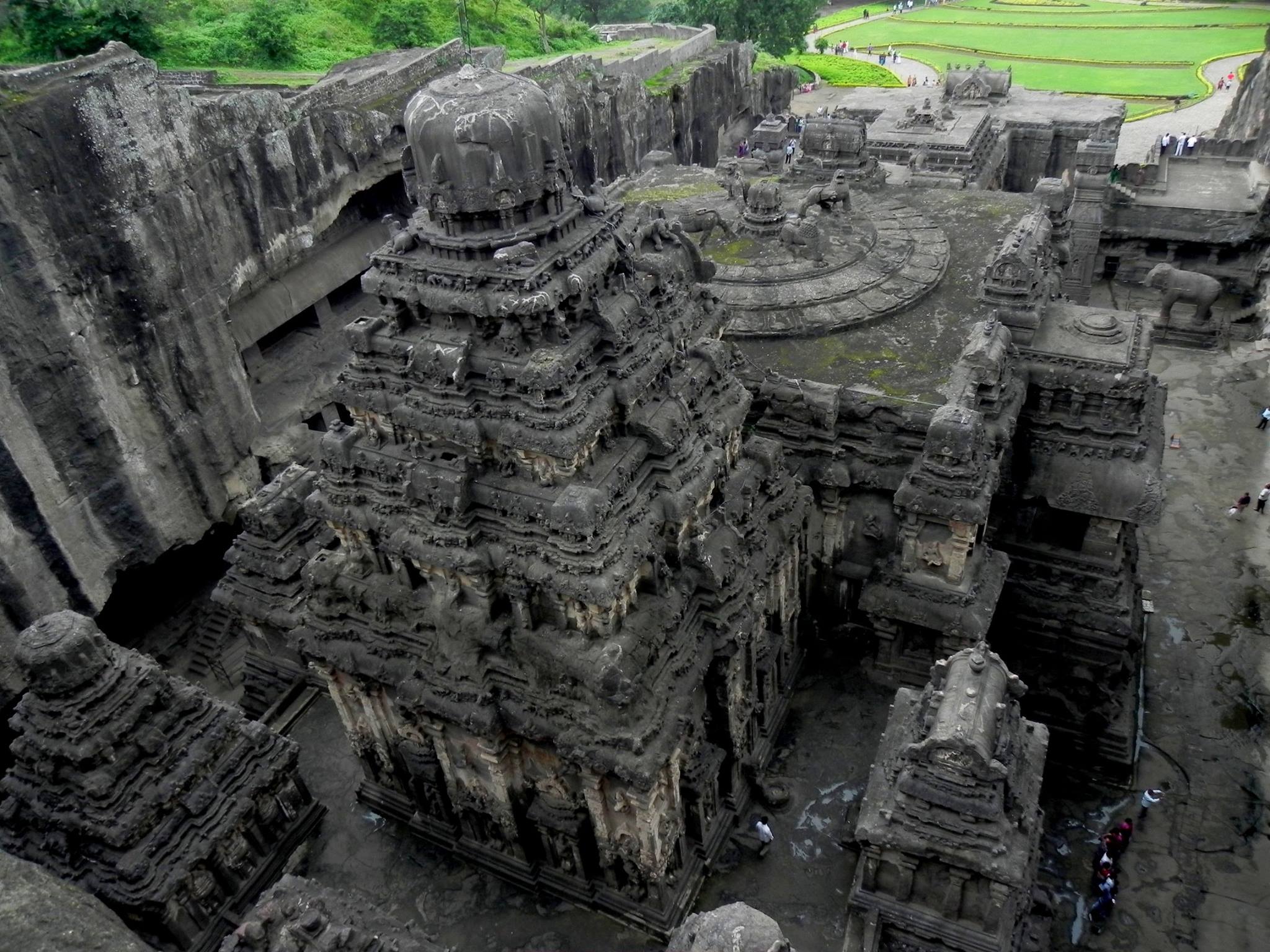If you are planning a visit to Aurangabad, then you must visit the Kailash Temple, Ellora. It is a magnificent architectural marvel, one that baffles modern-day engineers and architects. What makes this Kailash Temple special is the fact that it is one gigantic monolithic structure carved out of a single rock. Imagine our ancestors having achieved this feat in a time without modern technology, cranes, etc.
The Kailash Temple, Ellora is also known as the Kailasanatha Temple. It is a remarkable rock-cut Hindu temple located in the Ellora Caves complex in Aurangabad in Maharastra, India. The temple is one of the largest monolithic structures in the world, covering an area twice the size of the Parthenon in Athens. Its intricate carvings, sculptures, and architectural details are awe-inspiring, showcasing the skill and craftsmanship of ancient Indian artisans.
Kailash Temple, Ellora History
The Kailash Temple is the sixteenth cave, and it is one of the 32 cave temples and monasteries forming the magnanimous Ellora Caves. As per the historical records, it was built by the 8th century Rashtrakuta King Krishna I between the years 756 and 773 AD. Further, the non-Rashtrakuta-style temples located close by denote the involvement of Pallava and Chalukya artists.
The construction of the temple involved thousands of laborers, sculptors, and artisans who meticulously carved the temple out of a single rock monolith. The construction was a vertical excavation, carvers started at the top of the rock and carved it downwards. The temple is dedicated to Lord Shiva and is designed to resemble Mount Kailash, the abode of Lord Shiva in the Himalayas.
Legend behind Kailash Temple in Ellora
According to a Legend, According to this legend, the local king suffered from a severe disease. His queen prayed to the Lord Shiva to cure her husband. She vowed to construct a temple if her wish was granted, and promised to observe a fast until she could see the shikhara or top of this temple.
After the king was cured, she requested him to build a temple immediately, but multiple architects declared that it would take months to build a temple complete with a shikhara. One architect named Kokasa assured the king that the queen would be able to see the shikhara of a temple within a week. He started building the temple from the top, by carving a rock. He was able to finish the shikhara within a week, enabling the queen to give up her fast.
Kailash Temple, Aurangabad Architecture
The architecture of the Kailash Temple is predominantly Dravidian in style, characterized by its pyramid-shaped tower or shikhara, intricate carvings, and sculpted panels. The temple’s layout includes a gateway, a large courtyard, a main shrine housing the lingam (the phallic symbol representing Shiva), and numerous smaller shrines, pavilions, and galleries.
The temple is adorned with an astonishing array of sculptures and carvings depicting various Hindu deities, mythological scenes, and intricate details of everyday life. The carvings include gods, goddesses, celestial beings, animals, and motifs like lotus flowers and mythical creatures.

The exterior of the temple is embellished with elaborate carvings, while the interior features intricate pillars, ceilings, and walls adorned with sculptures and reliefs. The temple’s design and sculptures are rich in symbolism, representing various aspects of Hindu cosmology, mythology, and philosophy. The temple’s construction also symbolizes the journey of the soul towards enlightenment, with its complex layout mirroring the complexities of the spiritual path.
The Kailash Temple is part of the larger Ellora Caves complex, which comprises Buddhist, Hindu, and Jain rock-cut temples and monasteries. These Ellora Caves, including the Kailash Temple, are designated as a UNESCO World Heritage Site and are of immense historical and cultural significance. They offer insights into ancient Indian civilization, religious practices, and architectural techniques.
Kailash Temple, Aurangabad Visit Experience
- Arrival: When you arrive at the Ellora Caves complex, you’ll start at the entrance area, where you can purchase tickets and enter the site.
- Approaching the Temple: The Kailash Temple is located in the western section of the Ellora Caves complex. As you make your way towards it, you’ll pass by other impressive rock-cut temples and caves, each with its own unique architectural and artistic features.
- Marveling at the Temple: When you reach the Kailash Temple, you’ll be struck by its grandeur. Carved out of a single massive rock, the temple stands tall, surrounded by intricately carved sculptures and friezes depicting Hindu mythology.
- Exploring the Temple Complex: Take your time to explore the temple complex. Walk around the exterior to admire the detailed carvings, including those of gods, goddesses, celestial beings, and mythical creatures. Notice the intricate architectural elements such as pillars, arches, and decorative motifs.
- Entering the Inner Sanctum: While visitors cannot enter the inner sanctum of the temple, you can still peer inside to catch a glimpse of the lingam, the sacred symbol of Lord Shiva, which resides there. Witnessing the rituals performed by priests and devotees can be a spiritually enriching experience.
- Taking in the Atmosphere: Spend some time soaking in the atmosphere of the temple complex. Marvel at the craftsmanship of ancient artisans and imagine the dedication and effort it took to carve such a monumental structure out of solid rock.
- Learning from Guides: If available, consider taking a guided tour of the Kailash Temple. Knowledgeable guides can provide valuable insights into the history, architecture, and significance of the temple, enhancing your overall experience.
- Exploring Nearby Attractions: After visiting the Kailash Temple, you can continue exploring the other caves and temples in the Ellora complex. Each cave has its own story to tell, offering a deeper understanding of India’s rich cultural and religious heritage.
Few points to Remember before you visit Kailash Temple, Ellora
Remember to wear comfortable clothing and footwear, as you’ll be walking and climbing stairs during your visit. Also, bring along water and sun protection, as the site can get quite hot, especially during the summer months.
Remember to have your cameras or mobiles where night photography can be done since a lot of the cave structures are quite dark. You should also keep some chocolate or energy bars handy since the entire visit will be time-consuming and it can take a lot of energy to keep going. Enjoy your visit to the magnificent Kailash Temple at Ellora!
If you are looking for options in Kashmir, check out my posts on Pahalgam, Gulmarg, Snowfall in Kashmir, and Best Time to Visit Kashmir. If you are looking for options in Ladakh, check out Ladakh Weather, Nubra Valley, 5 Days Kashmir Itinerary, Best Packing tips for Ladakh & best tourist places in Ladakh.
If you are looking for something in Sikkim, check Tsomgo Lake and Batasia Loop. If you are looking for some jungle safari read, Gir Safari.
If you are looking for places to visit in the Andaman Islands, please check my post on Radhanagar Beach & Ross Island.
If you are looking for other options, check my posts on Murud Janjira, Kashid, Pirwadi Beach and Kihim Beach in Maharashtra or Malshej Ghat, Matheran Resorts, Paithan Dam (Jayakwadi Dam) & Mahabaleshwar. Alternatively, if you are interested in some Religious tourism, please check my posts on Golden Temple, Kamakhya, Trimbakeshwar, Somnath Temple and Kashi Vishwanath. If you are looking for North East Adventure tours, check my posts on Shillong, Meghalaya, Dawki, Double Decker Living Root Trek, and 7-Day North East Itinerary.
If you are looking for some spirituality, you can check out Ganga Aarti in Dashashwamedh Ghat or Ghats in Varanasi. Check out my posts from South India Sri Venugopala Swamy Temple, Bandipur Safari, and Mandalpatti Peak.


9 thoughts on “Kailash Temple, Ellora – 5 Interesting Facts”